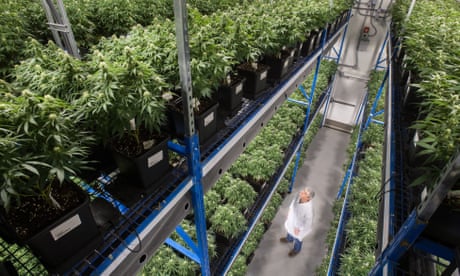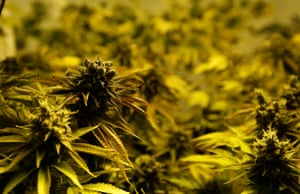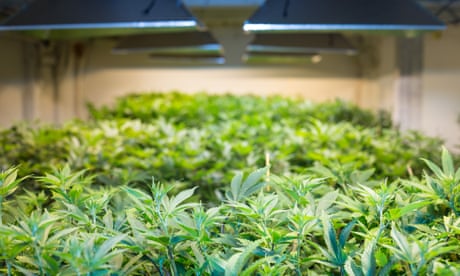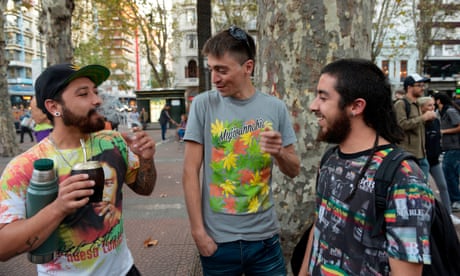Not so green: how the weed industry is a glutton for fossil fuels
Producing a few pounds of weed can have the same environmental toll as driving across America seven times – harming cities’ and states’ plans to curb emissions
As he opens the steel door to the jumble of his office, located in a cloistered warehouse on the west side of Denver, Paul Isenbergh is barking down the phone about a duplicitous business rival. He’s wearing a shirt and rust-colored tie. Yards from his desk, rows of drying cannabis plants are strung up on two clothes lines.
Isenbergh spent 30 years as a real estate broker in Florida. When he moved to Denver in 2011, he didn’t even know medicinal marijuana was legal in Colorado.
“I had been doing my own research and development, you could say, since the 1970s, but I didn’t really know anything about it until I came here,” he said.

He now owns three cannabis-growing facilities, all housed in what were shuttered Denver warehouses. The second largest, a windowless blockhouse that holds around 500 cannabis plants, throbs with energy.
Large 1,000-watt lamps bathe the plants in a blueish hue during the vegetative phase, when the plants are gaining mass, while a fizzing yellow light scorches the vegetation as it enters its flowering phase, producing the buds of weed that are trimmed, cured and sold for around $1,400 a pound. (It used to be much more, before a stampede of growers saturated the local market).
“We are consuming a lot of energy compared to what we would with LED lights,” said Isenbergh, who pays at least $4,000 a month for electricity. “We tried LED but we couldn’t get the right yield from the plants. And this is a weight game. The LEDs just don’t have the horsepower.”
The legalization of cannabis (recreational weed was approved in a statewide ballot in 2012) has reinvigorated previously dilapidated industrial areas of Denver and generated more than $1bn a year in taxable sales. But the voracious energy consumption of growers is rubbing up against the city’s ambitions of cutting greenhouse gases.
And with around half of all US states now allowing cannabis for various uses, hothoused cultivation is increasingly a concern for governors and mayors promising to fill a Donald Trump-sized hole in emissions reductions.

Evan Mills, a senior scientist at the University of California, was one of the first researchers to quantify how energy hungry the nascent industry is, estimating in 2011 that indoor cannabis cultivation represents 1% of total electricity use across the US, a figure backed up by a New Frontier study last year.
Lighting can comprise up to half of a cannabis grower’s energy use, with the desire to create a round-the-clock version of natural growing conditions requiring hugely powerful high pressure sodium (HPS) lights. These lights are on a par with those found in hospital operating rooms, throwing out around 500 times the illumination recommended for reading.
As a result, producing just a couple of pounds of weed can have the same environmental toll as driving across America seven times. Cannabis may still invoke thoughts of small-time, hippyish pursuits but the actual energy impact of indoor growers is on a par with humming data centers, Mills’s study found.
The cannabis industry gets undue blame for being wasteful. We are trying to overcome the stigmaKayvan Khalatbari
“The sad irony is that legalization is probably the only avenue for solving the problem, if only policymakers would confront it,” Mills wrote last year, ahead of ballot measures that led to the legalization of recreational or medicinal marijuana in eight states including California, Florida and Massachusetts.
“Until then, some of the nation’s hard-earned progress towards climate change solutions is on the chopping block as regulators continue to ignore this industry’s mushrooming carbon footprint.”
Denver’s electricity use has been edging up at a rate of more than 1% a year, with nearly half of that increase due to marijuana-growing facilities, the city has said. While just a small percentage of Denver’s electricity is used by cannabis operations, they are far more energy intensive on a per-square-foot basis than most other types of businesses. This demand, in turn, drives fossil fuel use, because Colorado gets the majority of its energy from coal-fired power plants.
“It’s definitely an area of concern,” said Emily Backus, sustainability advisor for the city. Denver has a goal to shrink its greenhouse gas emissions 80% by 2050, largely through boosting renewable energy, improving the efficiency of buildings and promoting public transit and electric cars.

Pot is power hungry: why the marijuana industry’s energy footprint is growing
Read more
It also signed on to the Paris climate agreement’s goals after Trump yanked the US out of the accord, mayor Michael Hancock decrying the “serious threat to our economy and way of life” posed by global warming.
On cannabis, Denver is taking the voluntary approach – Mills has argued mandatory energy efficiency should be enforced by municipalities – by convening a working group and pulling together a document on best practice on energy and water use, set to be released later this year.
The city has a capped limit on the number of commercial cannabis growing licenses it gives out (currently around 350) and most were quickly snapped up following legalization. But almost every grower then faced the same array of challenges in successfully growing weed at a large volume.
In order to calibrate conditions to reap multiple harvests a year, growers have to bake the plants in light while cranking the air conditioning to ensure rooms stay at a finely balanced temperature. A dehumidifier is used to prevent mold, carbon dioxide is pumped in to bolster growth and fans mimic the presence of a breeze. Irrigation systems are often hoses plugged into the plants, leading to tubs of water. The goal is healthy, weighty buds.
All of this uses a lot of energy and LEDs, despite saving a lot of power, have been deemed by many growers to be less effective and more expensive than HPS lights.
“There are so many snake oil salesmen out there trying to sell you their LEDs,” said Kayvan Khalatbari, founder of a cannabis consulting firm and mayoral candidate. “So you are bound to be suspicious. The cannabis industry gets undue blame for being wasteful. We are trying to overcome the stigma.”
‘The innovation has been astounding’
The glut of hash in Colorado – cannabis can’t be sold or taken across state lines – has sparked a price war that has forced some growers to look to their energy costs as a way to plump up profits. Some have gone down the organic route, such as L’Eagle, a dispensary and grow facility that that resembles the offspring of a spa and a high security health foodstore.
Visitors have to show ID at two windows in order to first access the store and then purchase their goods – Colorado demands buyers must be at least 21 and can only buy one once at a time. The well-scrubbed retail space has cabinets full of stativas, more uplifting and energy-giving strains, and indicas (or “in der couches” as co-owner Amy Andrle calls them) which cause drowsiness and dull pain.
The range we have is like having whiskeys and beers alongside Chardonnay. There’s a new demographic looking to cannabisAmy Andrle, L’Eagle
The variants have names like Death Star and Strawberry Cough and are sold alongside vape cartridges, hash water and cannabis-tinged chocolate, replete in child-proof packaging.
“The range we have is like having whiskeys and beers alongside Chardonnay,” said Andrle. “There’s a new demographic looking to cannabis, such as baby boomers who realise they don’t need to take Ambien to get to sleep anymore.”
Andrle is a smartly dressed former art gallery manager. With her husband and co-owner John, all plaid shirt and trimmed beard, she represents a new face of the cannabis business that looks more Bay Area than Cheech and Chong.
L’Eagle sells recreational cannabis from a former T-shirt manufacturing plant, which includes a growing facility with around 2,000 plants. The business doesn’t use synthetic pesticides, hand waters the plants, gives discounts to customers who arrive via bicycle and asks people to not idle their cars outside.
The dispensary was the first in Denver to get the city’s green stamp of approval and the growing area has taken a partial leap with LEDs by using them in the larger vegetative area, only using HPS in the flowering rooms. This saves the company around $1,800 a month on its electricity bill.
“The cannabis industry is often pigeonholed as being very heavy users of resources,” said Andrle. “It’s true we do have those needs but we are being evaluated against agriculture that’s been around for hundreds of years. No-one could really do the research on lighting or other technology until we could step into the light with legalization, the innovation since then has been astounding.”

Uruguay, the first country where you can smoke marijuana wherever you like
Read more
Still, LEDs aren’t in themselves a perfect answer. Because marijuana generally takes longer to mature under LEDs, it can result in not much energy being saved. And large greenhouses such as Strawberry Fields’ two-acre facility in Pueblo County still need supplemental lamp light alongside natural sunshine.
Also, the federal government still considers cannabis an illegal drug, presenting growers and retailers with several problems. They cannot get tax breaks for solar panels, for example; nor can they get organic certification from the USDA.
Until these obstacles are resolved, cities and states will have to grapple with the environmental impact themselves, or hope a popular breakthrough technology arrives soon. For now, Colorado is set to launch a pilot program that will allow people to relax in a fug of cannabis, in licensed cafes.
“It won’t quite be like Amsterdam cafes but it will allow consumption in certain permitted places,” said Backus. “People are interested to see how it goes. Most people think that cannabis is part of the fabric now, that it’s a business that isn’t going away.
https://www.theguardian.com/society/2017/jun/20/cannabis-climate-change-fossil-fuels
